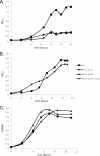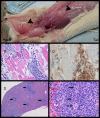Role of purine biosynthesis in Bacillus anthracis pathogenesis and virulence
- PMID: 21041498
- PMCID: PMC3019915
- DOI: 10.1128/IAI.00925-10
Role of purine biosynthesis in Bacillus anthracis pathogenesis and virulence
Abstract
Bacillus anthracis, the etiological agent of anthrax, is a spore-forming, Gram-positive bacterium and a category A biothreat agent. Screening of a library of transposon-mutagenized B. anthracis spores identified a mutant displaying an altered phenotype that harbored a mutated gene encoding the purine biosynthetic enzyme PurH. PurH is a bifunctional protein that catalyzes the final steps in the biosynthesis of the purine IMP. We constructed and characterized defined purH mutants of the virulent B. anthracis Ames strain. The virulence of the purH mutants was assessed in guinea pigs, mice, and rabbits. The spores of the purH mutants were as virulent as wild-type spores in mouse intranasal and rabbit subcutaneous infection models but were partially attenuated in a mouse intraperitoneal model. In contrast, the purH mutant spores were highly attenuated in guinea pigs regardless of the administration route. The reduced virulence in guinea pigs was not due solely to a germination defect, since both bacilli and toxins were detected in vivo, suggesting that the significant attenuation was associated with a growth defect in vivo. We hypothesize that an intact purine biosynthetic pathway is required for the virulence of B. anthracis in guinea pigs.
Figures









Similar articles
-
Differential contribution of Bacillus anthracis toxins to pathogenicity in two animal models.Infect Immun. 2012 Aug;80(8):2623-31. doi: 10.1128/IAI.00244-12. Epub 2012 May 14. Infect Immun. 2012. PMID: 22585968 Free PMC article.
-
Next-Generation Bacillus anthracis Live Attenuated Spore Vaccine Based on the htrA(-) (High Temperature Requirement A) Sterne Strain.Sci Rep. 2016 Jan 6;6:18908. doi: 10.1038/srep18908. Sci Rep. 2016. PMID: 26732659 Free PMC article.
-
Lethal factor is not required for Bacillus anthracis virulence in guinea pigs and rabbits.Microb Pathog. 2011 Nov;51(5):345-51. doi: 10.1016/j.micpath.2011.07.004. Epub 2011 Jul 20. Microb Pathog. 2011. PMID: 21791242
-
Proteomic studies of Bacillus anthracis.Future Microbiol. 2009 Oct;4(8):983-98. doi: 10.2217/fmb.09.73. Future Microbiol. 2009. PMID: 19824790 Review.
-
AtxA, a Bacillus anthracis global virulence regulator.Res Microbiol. 2010 Nov;161(9):735-42. doi: 10.1016/j.resmic.2010.09.006. Epub 2010 Sep 21. Res Microbiol. 2010. PMID: 20863885 Review.
Cited by
-
Identification of Burkholderia cenocepacia strain H111 virulence factors using nonmammalian infection hosts.Infect Immun. 2013 Jan;81(1):143-53. doi: 10.1128/IAI.00768-12. Epub 2012 Oct 22. Infect Immun. 2013. PMID: 23090963 Free PMC article.
-
RNA-seq and Tn-seq reveal fitness determinants of vancomycin-resistant Enterococcus faecium during growth in human serum.BMC Genomics. 2017 Nov 21;18(1):893. doi: 10.1186/s12864-017-4299-9. BMC Genomics. 2017. PMID: 29162049 Free PMC article.
-
Comparative Analysis of the Global Transcriptomic Response to Oxidative Stress of Bacillus anthracis htrA-Disrupted and Parental Wild Type Strains.Microorganisms. 2020 Nov 30;8(12):1896. doi: 10.3390/microorganisms8121896. Microorganisms. 2020. PMID: 33265965 Free PMC article.
-
Galleria mellonella as an Infection Model for Bacillus anthracis Sterne.Front Cell Infect Microbiol. 2019 Oct 18;9:360. doi: 10.3389/fcimb.2019.00360. eCollection 2019. Front Cell Infect Microbiol. 2019. PMID: 31681636 Free PMC article.
-
Silkworm model for Bacillus anthracis infection and virulence determination.Virulence. 2021 Dec;12(1):2285-2295. doi: 10.1080/21505594.2021.1965830. Virulence. 2021. PMID: 34490836 Free PMC article.
References
-
- Aiba, A., and K. Mizobuchi. 1989. Nucleotide sequence analysis of genes purH and purD involved in the de novo purine nucleotide biosynthesis of Escherichia coli. J. Biol. Chem. 264:21239-21246. - PubMed
-
- Beedham, R. J., P. C. Turnbull, and E. D. Williamson. 2001. Passive transfer of protection against Bacillus anthracis infection in a murine model. Vaccine 19:4409-4416. - PubMed
-
- Bennett, E. L. 1953. Incorporation of adenine into nucleotides and nucleic acids of C57 mice. Biochim. Biophys. Acta 11:487-496. - PubMed
Publication types
MeSH terms
Substances
LinkOut - more resources
Full Text Sources
Other Literature Sources
Medical
Miscellaneous

